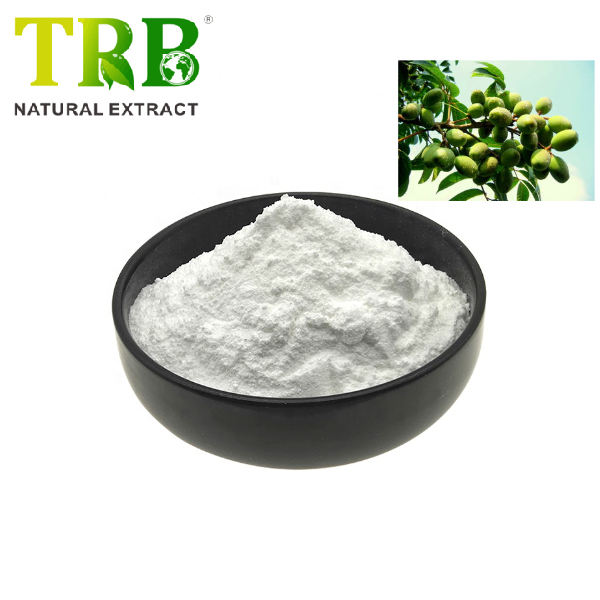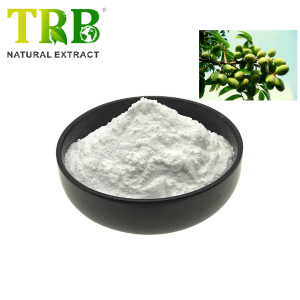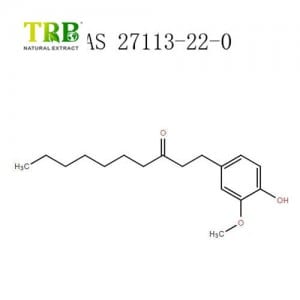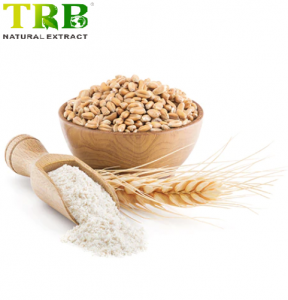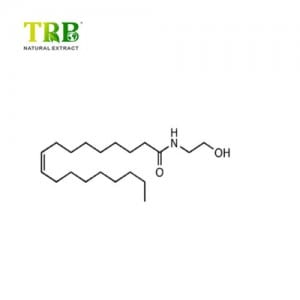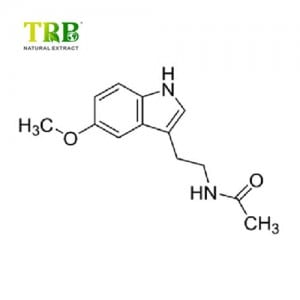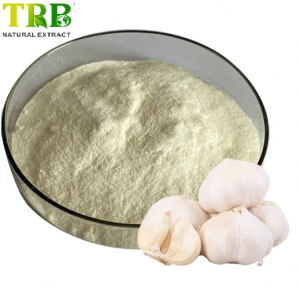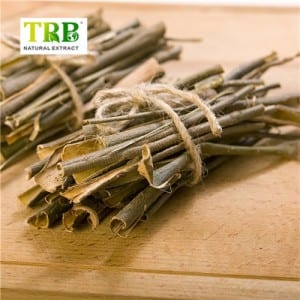Oleanolic acid omwe ali atatu pentacyclic triterpenoids olekanitsidwa ndi zomera za Gentianaceae za Swertia mileensis udzu wonse kapena privet chipatso, ndi thupi laulere ndi glycosides mu zomera zambiri.Oleanolic acid ali ndi mitundu yambiri ya zomera, ndipo pafupifupi 0.2% - 2%.Cucurbitaceae okhutira kwambiri ndi 1.5% ~ hunchback pansi 2%, privet zipatso zili 0.6% ~ 0.7%.Oleanolic acid ndi mtundu wa pentacyclic triterpenoid pawiri olekanitsidwa ndi chipatso cha mtundu Asteraceae, Syzygium sylvestris, kapena Ligustrum lucidum.Ndi chiwindi matenda adjuvant ndi matenda ntchito achire matenda.Acute jaundice hepatitis imakhala ndi zotsatira zodziwikiratu pakuchepetsa alanine aminotransferase ndi yellowing.Oolic acid ndi pentacyclic triterpenoids yomwe ili kutali ndi chipatso cha swertia chinensis kapena fructus ligustris kuchokera ku gentianaceae chomera.Oleanolic acid imapezeka kwambiri muzomera, ndipo imakhala ndi 0.2% ~ 2% [1].Zomwe zili pansi pa calabash zinali 1.5% ~ 2%, ndipo zomwe zili mu chipatso cha fructus ligustris zinali 0.6% ~ 0.7%.Oleanolic acid ndi woyera acicular crystal (ethanol), wopanda fungo komanso wosakoma.Osakhazikika ku ma acid ndi maziko.Malo osungunuka a 308 ~ 310 ℃, [alpha] 20 d + 73.3 ° (c = 0.15, chloroform, osasungunuka m'madzi, sungunuka mu methanol, ethanol, ethyl ether, acetone ndi chloroform.Oleanolic acid ndi yogawidwa mwachilengedwe, mochuluka kwambiri muzakudya ndi zomera zamankhwala, zokhudzana ndi betulinic acid Ikhoza kupezeka ku Phytolacca americana (American pokeweed), ndi Syzygium spp, adyo, ndi zina zotero.
Oleanolic acid adapezeka kuti akuwonetsa ntchito zolimbana ndi kachilombo ka HIV, gulu logwirizana la betulinic acid linagwiritsidwa ntchito popanga mankhwala oyamba oletsa kusasitsa malonda.Choyamba chinaphunziridwa ndikulekanitsidwa ndi zomera zingapo, kuphatikizapo Rosa woodsii (masamba), Prosopis glandulosa (masamba ndi nthambi), Phordendron juniperinum (chomera chonse), Syzygium claviflorum (masamba), Hyptis capitata (chomera chonse), ndi Ternstromia gymnanthera (mlengalenga). gawo).Mitundu ina ya Syzygium kuphatikiza java apple (Syzygium samarangense) ndi maapulo a rozi ali nazo.
Dzina la mankhwala: Oleanolic Acid98%
Kufotokozera: 98% ndi HPLC
Gwero la Botanic: Olea Europea Extract
Dzina Lamankhwala:(3β)-3-Hydroxyolean-12-en-28-oic acid
Nambala ya CAS:508-02-1
Gawo Logwiritsidwa Ntchito:Leaf
Mtundu: ufa woyera wokhala ndi fungo komanso kukoma kwake
Mkhalidwe wa GMO: GMO Yaulere
Kulongedza: mu 25kgs fiber ng'oma
Kusungirako: Sungani chidebe chosatsegulidwa pamalo ozizira, owuma, Khalani kutali ndi kuwala kwamphamvu
Shelf Life: Miyezi 24 kuyambira tsiku lopangidwa
Ndi chiyanioleanolic acid?
Oleanolic acid (OA), hydroxyl pentacyclic triterpenoid acid (HPTA) yofanana ndi betulinic acid, ursolic acid;ili ndi zopindulitsa monga antibacterial, anti-inflammatory, antitumor ntchito.

Mungapeze kutioleanolic acid?
Oleanolic acid wakhala akugwiritsidwa ntchito pochiza matenda osiyanasiyana, mukhoza kuwapeza muzakudya ndi zomera zambiri.
Zipatso zina monga maapulo, makangaza, mandimu, bilberries, azitona zilinso ndi oleanolic acid.

| Dzina la Herb | Oleanolic acid ali nawo | Njira yoyesera |
| Ligustrum lucidum Ait | 0.8028% | Mtengo wa HPLC |
| Verbena Officinalis L | 0.071%-0.086% | Mtengo wa HPLC |
| Prunella vulgaris L | 3.47% -4.46% | Mtengo wa HPLC |
| Hemsley Chinensis Cogn. | 1.5% ~ 2% | Mtengo wa HPLC |
Panopa Chinese therereHemsley Chinensis Cognakadali zida zamalonda kwambiri zopangira oleanolic acid.
Hemsley Chinensis Cogn.Mawu Oyamba
Hemsleya chinensis Cogn.ndi osatha kukwera therere, komanso ndi chikhalidwe Chinese mankhwala.
Mtundu: Cucurbitaceae
Tribus: Gomphogyneae
Mtundu: Hemsleya
Mitundu: H. mabilis
The therere amafalitsidwa m'zigawo Guangxi, Sichuan, Guizhou, Yunnan, Hubei, etc. Anabadwira m'mphepete mwa nkhalango ndi chigwa zitsamba pa okwera pafupifupi 2,000 mamita.
Zosakaniza zogwira ntchito: zili ndi Hemslolide Mal, Ma3, H1;Chikusetsaponin-Iva;dihydro cucurbitacin F-25-acetate;dilydrocucurbitacin F;oleanolic acid-beta-Hlucosyloleanolate;Hemsamabilinin A;Cu-curbitacinⅡb-2-beta-D-glucopyranoside.
Makhalidwe Amankhwala:
Hemsleya chinensis Cogn.ndi makamaka kuchotsa poizoni, kutsekereza, odana ndi kutupa, kulimbikitsa m'mimba ndi kuthetsa ululu.Panopa, pali akupanga ufa, kapena pawiri kukonzekera monga makapisozi, mapiritsi, m`mimba mapiritsi, etc., amene chimagwiritsidwa ntchito pachipatala kuchita.

Kuchotsa oleanolic acid kuchokeraHemsleya Chinensis Cogn.

Mafomu okhala ndi Oleanolic acid mu Zakudya zowonjezera
Tidapeza kuti oleanolic acid omwe amagwiritsidwa ntchito pazowonjezera zaumoyo amachokera ku mitundu itatu yazitsamba zamasamba: Loquat leaf extract, Hemsley Chinensis extract, and Holy Basil extract.
- Basil woyera ufa (tsamba) (0.4% Ursolic acid ndi Oleanolic acid, 2.0 mg)
- Holy Basil supercritical CO2 Tingafinye (tsamba) (Ocimum tenuiflorum Linn.) (2.5% Ursolic acid ndi Oleanolic acid, 1.5 mg)
- Loquat Extract (chipatso) (yopereka Ursolic acid, Oleanolic Acid) (Yokhazikika ku Ursolic acid Pa Kutumikira 125mg)

Oleanolic acid VS Ursolic acid
Oleanolic acid (OA) ndi ursolic acid (UA) ndi ma triterpenoids achilengedwe omwe ali ndi mawonekedwe ofanana ndi mankhwala.
Ma triterpenoids awa amadziwika kuti amapezeka m'zitsamba zamankhwala ndi zakudya.
Amakhala ndi zinthu zambiri zodziwika bwino zamankhwala: hepatoprotective, anti-inflammatory, antimicrobial, hypoglycemic, antimutagenic, anti-HIV ntchito, antioxidant, ndi antifertility.

Kusiyana kwa OA ndi UA:
| Dzina lazogulitsa | Oleanolic acid | Ursolic acid |
| CAS NO. | 508-02-1 | 77-52-1 |
| Pentacyclic triterpenes | β-Amyrin | α-Amyrin |
| Magwero a zitsamba | Tsamba la Loquat, Basil Woyera, Rosemary, tsamba la Azitona.etc. | |
| Zofotokozera | 40%,98% ufa | 15%,25%,50%,98%ufa |
| Maonekedwe (mtundu ndi fungo) | 40% kuwala chikasu98% woyera ufa wopanda fungo | 15% -50% bulauni-chikasu kapena chikasu98% ufa woyeraMakhalidwe |
| Kusiyanitsa | IR: (1355 ~ 1392cm-1) nsonga ziwiri (1245 ~ 1330cm-1) nsonga zitatuNMR: δ (C12122.1,δ(C13) 143.4 | (1355 ~ 1392cm)-1nsonga zitatu (1245 ~ 1330cm-1) nsonga zitatuδ(C12125.5,δ(C13) 138.0 |
| Zotengera | Oleanolic sodium saltOleanolic acid phosphate disodium mchere3-oxo oleanolic acid bardoxolone methyl (CDDO-Me) | Ursolic sodium mchere ndi dicarboxylic asidi theka la ester zotuluka Ursolic asidi ketene zotuluka 3-carbon ursolic acid 3-acetoxyursolic acid |
| Anticancer yotheka | UA ndiyotchuka kwambiri kuposa OA. | |
Biological Zochita za Oleanolic Acid
-
Anti-Chotupa / Anti-Cancer Effects
Kuletsa kwa oleanolic acid pa hepatocellular carcinoma kudzera pa ERK-p53-mediated cell cycle kumangidwa ndi apoptosis yodalira mitochondrial
- ndi Xin Wang, Hua Bai, etc. Ofufuza
OA idawonetsa zoletsa pa HCC kudzera pakulowetsa apoptosis ndi kumangidwa kwa cell cycle mu zotupa zomwe zidasiyidwa komanso m'maselo a HepG2.
OA inachititsa apoptosis kudzera mumsewu wa mitochondrial, zomwe zikuwonetsedwa ndi kulepheretsa kwa cholinga cha Akt/mammalian cha rapamycin pathway.
OA idapangitsa G2/M cell kumangidwa kudzera mu p21-mediated down-regulation of cyclin B1/cdc2.
OA adawonetsa zochitika zazikulu za antitumor mu HCC mu vivo ndi mu vitro zitsanzo.Deta iyi imapereka chidziwitso chatsopano panjira zomwe zimayambitsa antitumor athari ya OA.
Kuphatikiza apo, kafukufuku akuwonetsa kuti OA ndi otumphukira ake a Oleanolic acid methyl ester amakhalanso ndi vuto pa khansa ya m'mawere, khansa ya m'mapapo, khansa ya chikhodzodzo, khansa ya pachibelekero, ma cell a khansa ya pancreatic ...

-
Antimicrobial Activity
OA ikuyembekezeka kukhala ndi zochita zolimbana ndi tizilombo toyambitsa matenda osiyanasiyana chifukwa imagwira ntchito yofunika kwambiri poteteza tizilombo toyambitsa matenda muzomera.
OA inawonetsa zochita zolimbitsa thupi motsutsana ndi Staphylococcus aureus ndi Bacillus Thuringiensis pa 62.5 µg/mL ndi Escherichia coli, Salmonella Enterica, ndi Shigella dysenteriae pa 31.2 µg/mL minimum inhibitory concentration (MIC).
-
Hepatoprotective Ability
Chimodzi mwazinthu zodziwika bwino za OA ndikuteteza chiwindi ku kawopsedwe ndipo pano chikugwiritsidwa ntchito ngati mankhwala ophatikizira ku chiwindi ku China.
Mu makoswe a Wistar albino, OA yochokera ku Flaveria Trinervia inagwiritsidwa ntchito ndipo inali ndi zotsatira zoteteza kwambiri pa chiwopsezo cha chiwindi cha ethanol pobwezeretsa ma enzyme a hepatotoxic serum marker.Kafukufukuyu adawonetsa mphamvu ya antioxidant ya OA ngati njira ina yotheka ya kuthekera kwake kwa hepatoprotective.
Oleanolic Acid ndi zotumphukira zake

Oleanolic Acid Clinical Trials
Oleanolic acid (yochokera ku azitona), pali pafupifupi 500 yoyesedwa yolembetsa yachipatala, idawonetsa kuti idapindulitsa pamayesero azachipatala pa matenda osachiritsika a impso, matenda a shuga amtundu wa 2, ndi matenda ena otupa monga nyamakazi.
Zotengera zodziwika bwino pamayesero azachipatala ndi bardoxolone methyl (CDDO-Me).CDDO-Me idawunikidwa mu chotupa biopsies, ndipo itha kutengapo gawo pochiza matenda osachiritsika a impso, pano ikuwunikidwa pazovuta za matenda oopsa.
Chinese Pharmacopoeia Standard ya Oleanolic Acid
| Dzina la malonda | Oleanolic Acid |
| Chizindikiritso | (1) Tengani 30mg ya mankhwalawa, ikani mu chubu choyesera, onjezerani 3ml ya chloroform kuti musungunuke, onjezerani madontho awiri a sulfuric acid, gwedezani kwa mphindi 5, wosanjikiza wa chloroform ndi wofiirira-wofiira. |
| (2) Tengani pafupifupi 20mg ya mankhwalawa, onjezerani 1ml ya acetic anhydride, sungunulani ndi kutentha pang'ono, onjezerani sulfuric acid ku mtundu wofiirira, ndikuda mutatha kuyika. | |
| (3) Tengani pafupifupi 10mg ya mankhwalawa, onjezerani vanillin glacial acetic acid solution (tenga vanillin 0.5g, onjezerani 10ml ya glacial acetic acid kuti musungunuke, ndiko kuti) 0.2ml, kuwonjezera 0.8ml ya perchloric acid, ndi kutentha kwa mphindi zingapo. m'madzi osamba.Fuchsia, onjezerani 2ml ya ethyl acetate, yofiirira-yofiira kusungunuka mu ethyl acetate, yoyikidwa popanda kusinthika. | |
| (4) Mayamwidwe a infrared a mankhwalawa ayenera kukhala ogwirizana ndi mawonekedwe owongolera. | |
| Kukhazikika kwa chisokonezo | Tengani 0,15g ya mankhwalawa, muyese molondola, onjezerani 30ml wa ethanol, gwedezani, mutenthetse mumadzi ofunda kuti musungunuke, mulole kuziziritsa kutentha kwa chipinda, onjezerani madontho atatu a phenolphthalein indicator solution, pangani potaziyamu hydroxide solution ndi Mowa. 0.05mol/L) Titrate nthawi yomweyo ndikuwongolera mayeso opanda kanthu.Potaziyamu hydroxide solution (0.05 mol/L) pa 1 ml ya ethanol imagwirizana ndi 22.84 mg wa C.30H48O3. |
Oleanolic acid amalangiza mlingo
Malinga ndi Chinese Pharmacopoeia Standard, Oleanolic acid Oral mlingo ndi 20 ~ 80mg pa nthawi, 60 ~ 240mg patsiku.
Zotsatira zoyipa za oleanolic acid
Oleanolic acid amagwiritsidwa ntchito ngati mankhwala a hepatoprotective (OTC) kwazaka zambiri ku China.
Ngati bongo kapena zolakwika, ochepa odwala ndi youma pakamwa, kutsegula m`mimba, chapamwamba m`mimba kusapeza, ndipo akhoza kutha pambuyo symptomatic mankhwala.
Chonde funsani dokotala wanu kapena wazamankhwala musanagwiritse ntchito mankhwalawa.
Ntchito:
1.Oleanolic acid imakhala yopanda poizoni, antitumor, hepatoprotective, komanso imawonetsa ma antiviral properties.
2.Oleanolic acid adapezeka kuti akuwonetsa ntchito zolimbana ndi kachilombo ka HIV.
3.Oleanolic acid ndi chitetezo chachikulu cha maselo motsutsana ndi oxidative ndi electrophile stress.
4.Oleanolic acid ali kwambiri zotsatira trating HIV matenda a chiwindi, pachimake icteric chiwindi ndi matenda a chiwindi.
Ntchito:
1. Ikagwiritsidwa ntchito m'munda wa chakudya, imatha kukhala ngati zopangira za tiyi kuti zichepetse phlegm;
2. Kugwiritsidwa ntchito m'munda wamankhwala, kumakhala mankhwala atsopano odana ndi khansa omwe ali ndi poizoni wochepa;
3. Ikagwiritsidwa ntchito m'munda wa zodzikongoletsera, imatha kulimbikitsa kuyenda kwa magazi ndikuchotsa chakumwa.
| Zambiri za TRB | ||
| Regulation certification | ||
| USFDA, CEP, KOSHER HALAL GMP ISO Zikalata | ||
| Ubwino Wodalirika | ||
| Pafupifupi zaka 20, kutumiza maiko 40 ndi zigawo, magulu oposa 2000 opangidwa ndi TRB alibe vuto lililonse, njira yapadera yoyeretsera, kuyeretsa ndi kuyeretsa kumakumana ndi USP, EP ndi CP | ||
| Comprehensive Quality System | ||
|
| ▲Njira Yotsimikizira Ubwino | √ |
| ▲ Kuwongolera zolemba | √ | |
| ▲ Njira Yotsimikizira | √ | |
| ▲ Njira Yophunzitsira | √ | |
| ▲ Protocol ya Internal Audit | √ | |
| ▲ Suppler Audit System | √ | |
| ▲ Makina Othandizira Zida | √ | |
| ▲ Dongosolo Loyang'anira Zinthu | √ | |
| ▲ Dongosolo Loyang'anira Zopanga | √ | |
| ▲ Packaging Labeling System | √ | |
| ▲ Laboratory Control System | √ | |
| ▲ Njira Yotsimikizira | √ | |
| ▲ Regulatory Affairs System | √ | |
| Sinthani Magwero Onse ndi Njira | ||
| Kuwongolera mosamalitsa zonse zopangira, zowonjezera ndi zoyikamo. Zokonda zopangira ndi zowonjezera ndi katundu wonyamula katundu ndi US DMF number.Several raw suppliers as supply assurance. | ||
| Mabungwe Ogwirizana Amphamvu kuti athandizire | ||
| Institute of botany/Institution of Microbiology/Academy of Science and Technology/University | ||
